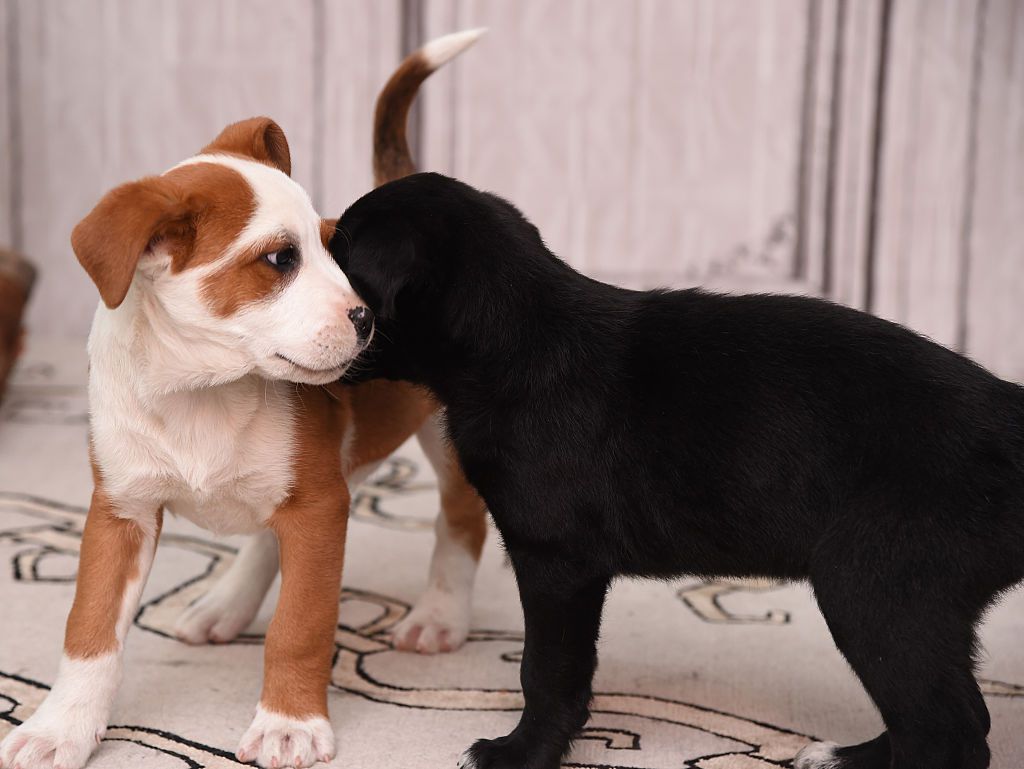
In This Chapter
- Recognizing how your puppy’s needs affect his behavior
- Teaching your puppy his first lessons
- Understanding your puppy’s emotional development
- Knowing how to socialize your puppy from the start
This chapter helps you understand the needs of your growing puppy. Here, you find all the information on how she thinks and how best to gauge your expectations at each developmental stage. During your puppy’s early months, the best investment of time is to socialize her to all life’s nuances. Advanced obedience lessons can wait, but you have a short window of opportunity to ensure that she’s comfortable with the world around her.
RememberPuppies are like developing children in many ways. Your puppy’s neediness must be your priority, as you help to shape her impulse control and communication skills. For now, her love and attachment to you is directly reflective on your daily interactions. Do it once and do it right.
If this chapter leaves you wanting a little auxiliary help, consider Puppies For Dummies (Wiley), written by one of the authors, Sarah Hodgson.
Creating a Lifelong Bond
Everyone who gets a puppy envisions an idealized relationship – a lifelong bond that fulfills all the reasons the puppy was adopted in the first place: to be a buddy for the children, a protection dog, a simple companion, and so on. This fantasy isn’t unusual or even unhealthy, but it is a fantasy. The truth of the matter is that puppies mature gradually, and their adult behavior is directly influenced by daily interactions and experiences. A lot of time, patience, and understanding go into raising a puppy. The more you can learn about your individual puppy’s needs and learning patterns, the greater your chance for mutual respect.
TipIs the experience of adopting a puppy already leaving you feeling overwhelmed and enslaved to your newest family member? It may help to know that most people feel this way at some point. Your only mistake may be in setting your expectations beyond your puppy’s capacity. Organize both your schedule and your surroundings to prevent mishaps to ensure that you can both meet your puppy’s needs and have time for yourself, too.
An alternative is adopting an older dog, or at least one that is past the puppy stage. The advantage is that someone else will have put in the hard work of living through the puppy stage. The disadvantage is that you don’t have the opportunity to shape your pet’s behavior exactly as you want, from the beginning.
Initially, your attention will encourage any behavior, so use this fact to your advantage and give your puppy every opportunity to behave well. Puppy-proof your home, leaving appropriate toys out to encourage good chewing habits; brace your puppy (see Seeing Life from Your Dog’s Perspective) to condition four-footed greeting manners; and use treat cups and other gadgets to motivate good behavior (see Inspiring Behavior with Motivational Techniques).
RemeberIf you have a young puppy, please spend more time encouraging her, rather than discouraging her, using the simple games and tricks mentioned throughout this chapter.
Meeting your puppy’s needs
A puppy has the same survival needs as a young baby – and the same dependency on others to provide for them. Each day, she needs to eat, drink, sleep, go to the bathroom, and play. All her needs are equal: If one is overlooked, you pay a high price. Babies cry when they need something. For puppies, the signs that they’re in need can include restlessness, whimpering, or even nipping.
Meeting your puppy’s needs goes a long way in the bonding process. The person who is most consistently there to take care of a puppy’s needs will be revered. Try to read your puppy’s signals so that you can address her needs before they become intrusive. Good observation on your part can teach you your pup’s “native language,” and many of those signals will persist throughout life. Once you know them, you can understand what your pet is feeling and avoid problems that may arise if his needs aren’t met.
Warning!Puppies need a lot of sleep. If a puppy is overtired, she’ll display all the signs of a colossal meltdown: random motions, wild nipping, even snapping at the hands that hold her. If you suspect that your puppy is reacting out of exhaustion, don’t correct her. Calmly escort her to a quiet area, leaving her with a chew toy.
Providing early lessons
Puppies are eager to know things and are naturally conditioned to look to a leader for direction. Though you may be unaware, you carry a lot of weight in your puppy’s eyes: Be the leader or puppy parent that you would hope for.
Puppies have a short attention span: Keep lessons short and weave them into your daily interaction with them versus setting specific times aside, especially in the early months. Choose a word a week, such as “Sit” or “Give,” saying it to your puppy interactively as discussed throughout this book.
TipRefer to Inspiring Behavior with Motivational Techniques for a thorough description of positive training tools, such as treat cups, snack packs, and clickers. These items are equivalent to the candy and toys of our fondest childhood memories.
The detrimental effect of discipline Many of the most common frustrations with puppies (especially young puppies) are created by over-disciplining. Although this mistake is quite innocent, shouting “No” at a puppy under the age of 5 to 6 months is equivalent to yelling at a 1-year-old baby. The very person the puppy turns to protect her and interpret her new world has turned on her. The result is either panic, which people mistake as understanding, or a defensive stance that instills confrontation, not cooperation. Are you wondering how you can teach your puppy right from wrong? The short answer is that a very young puppy can’t grasp these concepts: Life is simply too new. Simply reward the behaviors that you like and ignore the others for now. |
Conditioning
Conditioning is the process of pairing a behavior to a word cue, until your puppy connects the two. For example, if you say “Get busy” as your puppy is eliminating, eventually this phrase prompts her to potty. Sound too good to be true? You can teach many behaviors and lessons this way! Just catch the action that you want while it’s in progress, attach a label to it, and then reward the pup.
TipYou may use treats to reward your puppy’s behavior initially, but phase off treating every time within a few weeks. Directions aren’t really learned until they can be prompted without food.
Leash training
Even if you don’t foresee using the leash often, your puppy should feel comfortable with it, as many situations require it (visiting the veterinarian, vacationing, and so on). Begin conditioning early!
- Initially supervise your puppy wearing a collar and then attach a leash and let her drag it for short, 10-minute periods. She may play with or carry it; don’t interfere.
- When your puppy no longer reacts to the leash or collar, pick up the leash and follow her about. Tug on it gently to introduce the feeling of pressure.
- Using treats and enthusiasm, coach her to follow you. When your puppy cooperates, say “Let’s go” and reward her.
Ringing bells and other housetraining signals
Often puppies understand the concept of going outside, but are unclear how to signal their people’s attention at the door. As you go to the door, say “Outside,” using the same door whenever possible. Secure a bell at your puppy’s nose level and tap it with your finger, or encourage a “Let me out” signal, such as barking just before opening the door.
Stairs
Many puppies are initially afraid of going up or down the stairs due to their physical awkwardness and a fear of the heights involved due to depth perception. At first, carry the pup up the stairs, and place him on the next to the last step, and encourage him up by patting the floor on the step ahead and giving treats. The same goes for going downstairs. Carry the pup to the next to the last step and encourage him to complete the short journey down. When he’s comfortable with two steps, go to three, and so on until he’s confident walking the entire staircase — up or down!
Word association
The best way to introduce directions to your puppy is by associating them with positive games and experiences. Here are some fun and cheerful conditioning games:
- Name game: Place several treat cups about the house or use a positive alerting signal like clapping or a whistle. Call your pup’s name after a short separation, kneeling down to bring yourself to her eye level. If she stops short, run away from her and clap your hands and repeat her name — she’ll follow out of curiosity! If other people want to join you, offer them a treat cup — and call your puppy from person to person.
Warning!If you repeat your puppy’s name when you want to isolate or groom her, you may notice that she stops getting excited when you call out to her. Stop in your tracks! Only call her by name for positive interactions.
- Sit, please: Teach your puppy to sit whenever she wants attention, toys, food, and so on. Don’t demand her response — simply position her as you direct her: Gently squeeze her waist muscles just below her ribs as you lift up her chin.
- Proper greeting: Puppies jump up to get closer to your face. Help your puppy learn a more acceptable greeting ritual. Whenever you greet your puppy or are introducing her to someone new, brace her by looping your thumb over the bottom of her collar and holding her waist to prevent jumping as you repeat the direction, “Say, hello.” Another option is the reverse yo-yo, as illustrated in Figure 8-1. Leave a 4-foot leash on your puppy and step on it before greeting your company. If your puppy does jump, he’ll be brought down: Introduce him when he’s calmer. (For more insights, see Addressing and Solving Problem Behavior.)
- Natural come: Say your dog’s name and “Come” when you and your puppy reunite. Place treats in your pocket or wear a snack pack and reward your puppy when she chooses to check in with you. As you hand her a reward, say “Come.” Within weeks she’ll be conditioned that “Come” means you’re close, and she, herself, will race over to close the gap.
Warning!The biggest mistake puppy people make is to teach this command when they’re standing apart from their puppy. A puppy then learns that “Come” highlights separation, not togetherness.
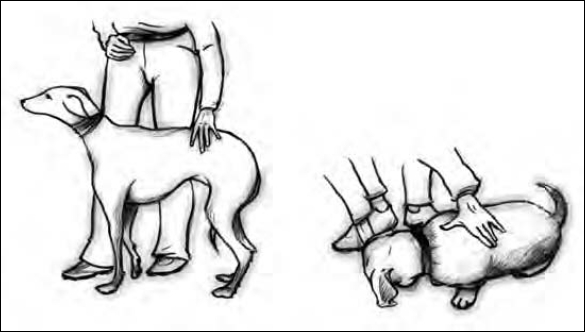
Figure 8-1: Using the reverse yo-yo technique during greeting.
Warning!You may give your puppy freedom in a fully enclosed area. If you’re playing in an open field or yard, leave a long line (see Inspiring Behavior with Motivational Techniques) on her to supervise her wanderings.
Preventing Problems
You’ve probably seen an aggressive, hyper, or fearful dog. Though each may look different to you, each dog is showing signs of stress experienced in puppyhood.
TipWatch for signals of your puppy’s confusion or stress, such as hyperactivity, excessive barking, jumping, or nipping. Intervention will help your puppy mature into a well-mannered family member.
For more thorough discussions about problem behaviors and their solutions, refer to Addressing and Solving Problem Behavior.
Aggressive puppy
An assertive puppy can either develop into a protective family member or into a dog who will use aggression to make a point. The choice is up to you. If you think your puppy has this potential, ask yourself:
- Does she bait you to play tug-of-war?
- Is she relentless in her demand for attention?
- Does she refuse to relinquish toys or food and growl or snap if you try to take them?
- Will she grab you with her mouth to prove a point or bark back when you correct her?
Though her earliest attempts at being the boss (in her puppy litter) may have been successful, show her that she is not the leader under your roof:
- Use a head halter, such as a Halti or Gentle Leader, to better control her.
- Consider using time-outs (see Addressing and Solving Problem Behavior) whenever the pup gets uppity. Direct him by voice or collar and simply say, “Time-out” while you place him into his kennel crate or a safe but uninteresting room such as the bathroom.
- Teach her other manners, such as sitting when she wants a toy or treat and lying down quietly with a bone when you’re preoccupied.
- Only attend to your puppy when she’s respectful of you.
Warning!If your puppy threatens or snaps at anyone, seek professional help. Although we can help control aggression (see Understanding and Resolving Aggressive Behavior), a full-blown aggressive response that threatens injury to someone requires instant attention and is beyond the scope of this book.
Hyper puppy
If your puppy has trouble with impulse control, you may mistakenly diagnose her as having an attention disorder. It’s not unheard of for a dog to suffer from this affliction, although it’s rare. Most hyperactivity results from inadvertent interactions given to a smart, energetic puppy. Eager to please, these puppies interpret any attention as positive and often note that wild behavior gets the biggest rise from those whom they love the most. If mania works, then mania it will be . . . in spades.
To avoid developing a manic puppy and a frustrated owner, simply place your dog in a time-out. The duration of time-out is determined by how long it takes him to calm down. Usually 3 to 5 minutes are all that’s needed.
Timid puppy
Is there a more pitiful sight in the world than a frightened puppy? Of course, the immediate human reaction is to smother this puppy with love and affection. That, however, isn’t an effective reaction. Puppies interpret our intention by how we look and not by what we’re saying: A lowered posture communicates fear, direct focus is questioning, and high-pitched tones are a clear sign of panic. To your puppy, you look scared, too.
RememberWhat a frightened puppy needs is a confident leader, so play the part: Stand tall and act cool.
Brace your puppy by kneeling down and holding her in a sit position or by holding her on a leash.
Whenever possible, step back from the stimulus to the point where your puppy is comfortable and be an example of confidence.
Use the socialization steps in this chapter to expose her to all that life has to offer, turning your “don’t-wanna-do-it” puppy into a cando dog.
Socializing Your Puppy
Your first priority is to socialize your pup. You’ll have plenty of time to “train” her later, but only a small window of opportunity to familiarize her with life’s nuances. If you miss out on experiences during this impressionable period (from birth to 14 weeks of age), many common situations and events will be unfamiliar to your puppy. What is unknown may provoke a whole host of undesirable responses, ranging from fear to aggression. During the socialization process, your puppy fills her memory bank with people and places that they successfully and safely encountered, and this will allow her to remain stable and confident. This section explains how to make socializing your puppy a positive experience for both of you.
Technical stuffYour puppy’s brain is still developing even though she’s 12 weeks or more of age. Though she will sleep a lot, her waking hours are spent absorbing experiences like a young child absorbs language.
TipIt is possible to begin introducing your puppy to new experiences as early as 4 weeks of age. After 14 weeks of age, your puppy will be more rigid in her associations and less impressed by your example. Use Table 8-1 to monitor your socialization program.
Developmental stages Puppies mature a lot like children, going through similar stages of development that are prompted by both self-awareness and hormonal release. Though certain stages can drag on, they won’t last forever, and believe it or not, some day these puppyhood gripes will be a distant memory. Infant (8–12 weeks): Also known as the angelic stage, most puppies sleep a lot and are relatively calm and observant when interacting. Though you can “train” your puppy at this age, her reactions are less learned than quick responses to get your attention. This phase is the ideal time to get your puppy to focus on lifelong routines, such as where to potty, what to chew, and where her resting areas are in each room. Terrible Twos (13–18 weeks): This stage heralds an immediate fall from grace as your puppy develops a growing awareness of both herself and the world around her. Though your puppy may seem sassy and defiant, don’t give up on her just yet: These are all signs of normal development and are often her way of dealing with her own emotional stress. Learn creative ways to direct her impulsivity and then let time and maturity take its course. Focus on play training and basic manners like sitting for rewards and alerting to her name. Lastly, don’t set yourself up for disappointment: Keep your home puppy-proofed and her schedule consistent. Budding adolescent (4 1/2 months–8 months): For some puppies, this stage is the most trying. Old puppyhood problems re-emerge with a new twist: control. This stage is when your puppy is determining her place in your household: Does she watch you or direct you? Now is the time to introduce the concept of “No” (see Communicating with Your Dog and Happy Training, Happy Tails) and structured lesson time. All directions should be reinforced throughout the day so that your budding adolescent can learn that your directions aren’t debatable. Puberty (8 months–11 months): Puberty is a nightmare for any species. Remember that your puppy is on an endless hormonal rollercoaster. You’ll have to endure this time. If you lose your patience, it will set you back, as your puppy is looking to you for a steady reaction. Repetitive lessons, a well-organized exercise plan, and containment around heavy distractions (for example, fenced area or leash) are musts. Young adult (11 months–18 months): If you’ve kept up with your puppy’s lessons, you’ll clearly note that the end is in sight. Some days your puppy behaves like a wellmannered dog. Your role now is to follow through when your puppy ignores you, position her if she chooses to go her own way, bring her into unfamiliar environments often to highlight your worldliness and leadership skills, and stay on top of her lessons. |
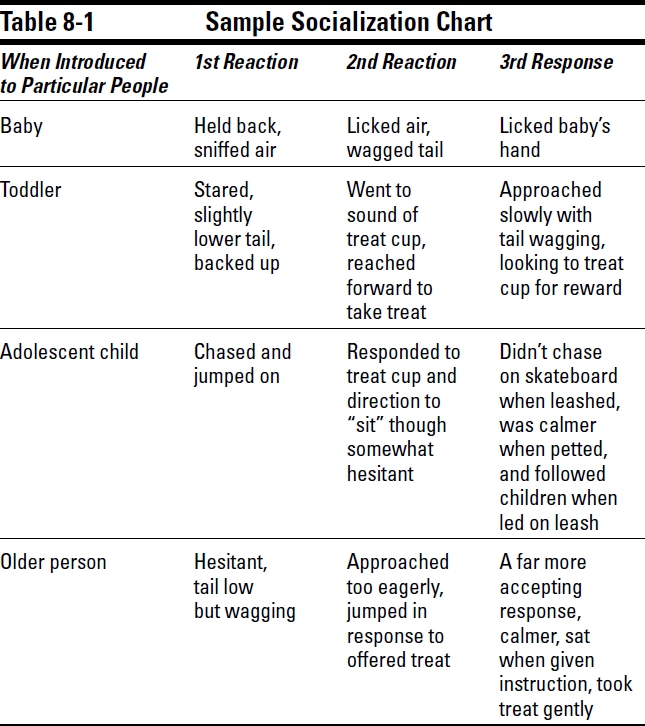
Warning!Don’t take your puppy out on the town until she’s gotten her inoculations and a thumbs-up from her veterinarian. Many airborne viruses can cause serious illness and even death.
Table 8-2 provides a list of things to socialize your puppy with.
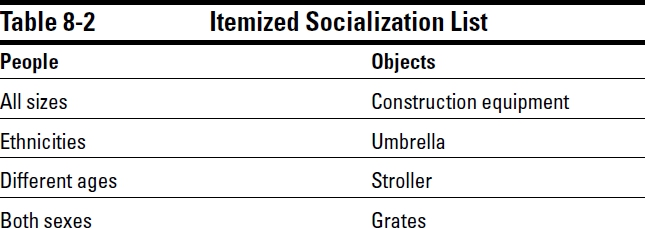
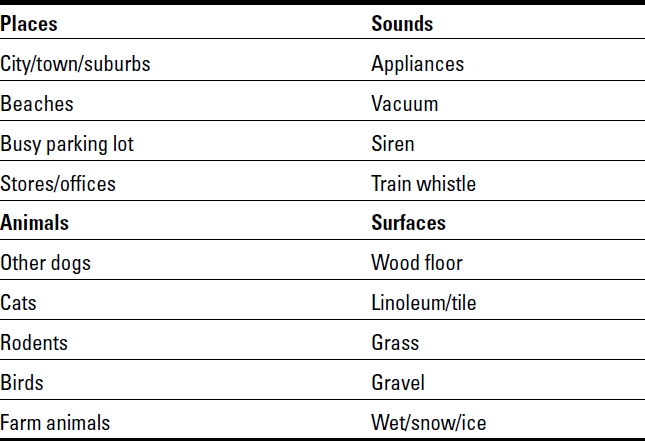
Creating a positive association
Take a cheerful attitude along when you’re socializing your puppy, as your example will help her feel comfortable in the world around her. Use treats, toys, and patience — whatever it takes to keep your puppy’s attention centered on you, as many new distractions can be frightening at first. Routine exposure will calm her reaction, and the time will be well spent: Your puppy will develop confidence in your worldliness and direction. Keep these things in mind as you socialize her:
- Use the right leash and collar. When you’re out and about, condition your puppy to the direction “Let’s go.” Find an effective collar (for rambunctious puppies consider a head collar, such as a Halti or Gentle Leader) or a no-pull harness (see Inspiring Behavior with Motivational Techniques), as they guide your puppy without putting undo strain on her developing neck or back, and use a 4- to 6-foot leash.
Warning!Avoid using long retractable leashes when socializing your puppy. This long lead gives your puppy far too much slack and endangers her safety near roadways. Such leashes are, however, useful when exercising your puppy in a field or on a beach instead.
- Focus on their curiosity. Most puppies stop in their tracks from time to time, refusing to move or freaking out when presented with a new situation. If you focus on your puppy at this time, you’ll cement her fear. Instead, relax your body and look inquisitive by approaching the person/object when possible. Focus your attention on your puppy only when she warms to a situation, even if it takes several exposures.
- Try coaxing gadgets. Using favorite treats and toys while you socialize your puppy is a given, but you may want to consider other gadgets, such as treat cups, clickers, and targeting wands (see Inspiring Behavior with Motivational Techniques). You can use these associations to lure your puppy closer to a distraction that makes her wary and to reward her when she exhibits confidence.
- Repeat exposures. Some puppies are hard headed: If they don’t like something, they stand firm. These pups need repeated exposures and positive modeling before they’ll relax their guard. Consider a street grate, for example. The image confuses their depth perception and arrests the motions of even the most confident puppy. If your puppy refuses to go near one, don’t avoid it. Create a can-do puppy by seeking out a grate each day and sitting by or on it as you lure your puppy closer with treats. Repeated exposure will do the trick – soon, your puppy will “catch your confidence” and approach with curiosity, not fear.
Warning!Does the thought of spending time socializing your puppy away from home seem like too much bother to you? If you’re fortunate enough to live within a private enclosure, and you don’t take the time to expose your puppy to other places, objects, and people, she may run the risk of territorial aggression or outside world phobias (growing wary of anything not found at her home base). If you ever want your dog to meet people and go to other places, you must do it or else spend the rest of the dog’s life dealing with fears and aggression.
Exploring places
Dogs are more home loving than people are and are truly content to spend all of their lives in the same locale. Though your dog may be content to never stray beyond the boundaries of your home, neighborhood, and surrounding area, for her to do so is unrealistic. You’re certain to take your dog out if only to the veterinarian or to the kennel during your holiday, although most people enjoy socializing with their dog elsewhere, too.
TipThe surest way to guarantee your puppy’s easy transition from one environment to another is by taking her with you often. If you live in the country, go to the city. If you’re an urban dweller, go find some clean fresh air. Take your puppy to town, beaches, and in anydog-friendly building or store. Use the following directions to lead her about, always playing the role of the social director. (Go to Communicating with Your Dog for more instruction on how to teach your puppy these directions.)
- “Follow” or “Let’s go”: This direction says, “I’m the leader, protector, and guardian — follow me!” When your puppy is walking behind you or standing behind you, she’ll feel safe and protected.
- “Wait” and “Okay”: Use this duo at all curbs, stairs, car doors, and thresholds, telling your puppy to stop at your side and look up to you before proceeding. These directions also communicate your reliability, saying, “Let me look ahead to make sure that we’re safe.”
- “Sit”: When you’re around distractions, your living-room champion may suddenly forget basic directions like “Sit.” Don’t despair — she’s just distracted. Position your puppy, teaching her to focus on your directions.
- “Stay”: This direction instructs your puppy to be still. If she’s unable to cooperate (for example, during a greeting), either brace her or stand on the leash. If you’re relaxing or eating, encourage stillness by sitting on the leash.
- “Under”: Say this direction when you’re sitting on a chair or bench, luring your puppy underneath your feet or the table leg with a toy or treat. This covered space helps your puppy feel protected and safe, and she will, in turn, be calmer.
- “Back”: If your puppy pulls to walk in front of you, say, “Back” as you direct her behind you. If this direction proves too difficult to master, review the proper handling of the leash and your collar choice (see Inspiring Behavior with Motivational Techniques). Make the appropriate changes.
TipUse these foundation words for all your socializing experiences. Familiar words instill focus and trust.
Meeting other people
Whether you desire a friendly dog or hope that your puppy develops protection skills, socialization is critically important. A wellsocialized dog has a broad horizon, having met all sorts of people, and isn’t easily derailed by new experiences. This dog has learned to trust her people’s responses and can easily identify those persons who have bad intentions.
Warning!If your puppy hasn’t met children by the time she’s a few months old, you’ll notice her alarming reaction when she’s confronted by them. Children smell different and look and move differently, too. Though each dog’s response is unique, many will act defensively or aggressively or exhibit active fear of children. Once they’ve passed the impressionable stage (up to 14 weeks old), you’ll have far less ability to positively influence their behavior.
Exposing to sounds
Your puppy is more acutely aware of sounds than you can imagine. We encourage you to expose your puppy to many different sounds.
If a certain sound startles your puppy, kneel down and brace her by holding her chest and back. Repeat “Stay” in a calm voice if she’s familiar with the direction; if your puppy is unable to relax, step back a comfortable distance, outside of her red zone — the distance away from the object at which she feels comfortable (see Figure 8-2). If possible, modify the sound or mute it and engage your dog in welcomed activities, such as treat-based lessons and games.
TipMost puppies are startled when experiencing their first thunderstorm. Your initial reaction to your puppy’s fear is critically important. If you coddle her, she’ll grow fearful, as your posture and tone conveys the equivalent of fear and confusion. A better approach is to act completely unbothered, standing tall and moving about as if nothing were going on. If your puppy doesn’t adopt your attitude, move into a small room, read, or chat on the phone. Above all else, stay calm. When she’s less stressed, praise, play, and reward her to encourage more outward focus than inward fear.
Surfaces Imagine life without shoes. Your dog walks on bare paws every day: New and unfamiliar surfaces will always give her reason to pause. Expose your puppy to as many surfaces as possible. If your puppy acts confused or startled when you walk onto a new surface, don’t drag her across it. Stop and sit a short distance from her and urge her to you with treats or a toy. When she gets to you, reward her for a few seconds, then place her back on the floor, and move a few feet away. Repeat the process several days in a row — spreading treats on the floor to override her trepidation. |
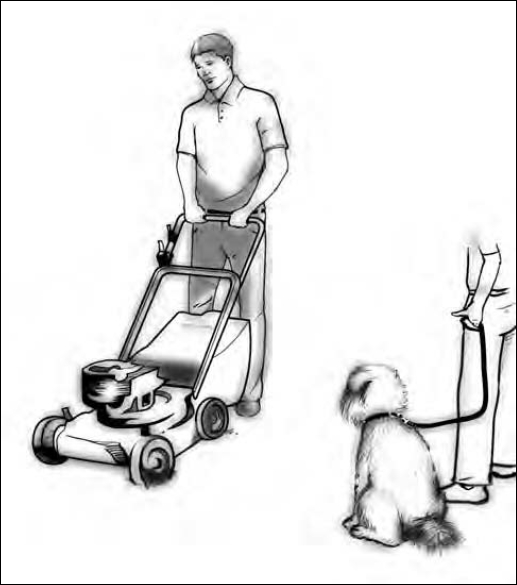
Figure 8-2: Recognizing your dog’s red zone.
TipIntroduce your puppy to as many indoor and outdoor sounds as possible. A vacuum cleaner can be as alarming as a siren if your puppy is unfamiliar with it. Use treats to measure her comfort zone: If she doesn’t take them, she’s in panic mode, so move back.
Introducing objects
The gift of socializing your puppy is the mutual benefit of being familiar with and relaxed around all life has to offer. Always remember that your puppy sees new objects differently than you do. For her to feel comfortable with anything, she must sniff it; her nose works like your eyes. For example, if you see a leaf bag blowing in the wind, you can interpret the sight from afar. Your puppy, on the other hand, can’t. If it’s a first encounter, he may act startled or even defensive until he’s willing to come close enough to sniff it.
The goal in early socialization is to build up your puppy’s bank of experiences so that throughout her life, she’ll be less surprised by the variety of things that life will throw at her. Refer to Table 8-2 or create your own list of objects that you’re likely to come across in your daily adventures. Introduce your puppy to these objects one at a time, always keeping in mind the following:
- If your puppy is startled, discover her red zone.
- Give her direction and treats at this distance. If she’s still unable to focus on you or the food, back away until she can.
- When you’re able, investigate the object yourself. Kneel down and pretend to sniff it — your puppy will trust in your bravery.
- As your puppy gets more familiar with the object, walk by it swiftly saying, “Let’s go.” Look straight ahead — your puppy will focus on your confidence.
Warning!Avoid the temptation to soothe your puppy if she’s fearful. She’ll interpret your soothing as submissive fear or confusion; instead of soothing her, it will underscore her concern.
Meeting other animals
No one wants a dog who’s either afraid of other animals or dangerously aggressive with them. To an undersocialized dog, however, the “unfamiliar” is always a potential danger, which can prompt a host of unpredictable behaviors.
Ask friends, neighbors, and other family members to bring over a variety of pets to meet and handle your puppy while still on a leash to allow you full control. Stay calm, modeling behavior that you want your puppy to emulate.
TipIf you can visit a farm or walk along a horse path or fence, do so. The more animals your puppy sees during this socialization time, the less they will worry him throughout your lives together.
by Stanley Coren and Sarah Hodgson





